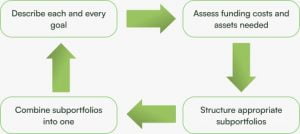In simple terms, investing is the process of putting money into different asset classes like real-estate, stocks/mutual funds or a commercial venture with the expectation of the money to grow. When one invests, they sacrifice their spending capabilities of today with the purpose of saving and investing for tomorrow.
When there is a fixed notion or goal of what one wants to do with the set-aside income in the future (after it has seemingly matured), it is called Goal Based Investing.
The income you set aside represents a future goal, whether it is for your child’s education, to buy a home or to get a regular income post-retirement. In order to achieve these goals a well-designed investment strategy needs to be followed, which focuses on how to reach that goal.
How does Goal Based Investing work?
Goal based investing involves keeping a specific personal goal in mind while choosing the method to invest. To simplify the process of goal based investing, one must always keep three questions in mind while planning towards reaching a goal :
- How much money do I need to achieve my goal?
- How much time do I have to grow my capital?
- What is the appropriate amount of risk I am willing to take to reach the required capital amount in the given time?
Think about all these questions and take into account all the factors affecting them. This could involve taking into consideration the economic condition as well as inflation among other factors.
No financial planning is complete without tracking progress. Tracking progress is the best way of assessing performance and making changes that could help ensure that the desired goals are met on time. Another thing to keep in mind is the method to track the progress of growth. It is great if our portfolio is outperforming the market index, but it will be of no use if we do not end up with the original goal we had set out to reach.
For e.g., If you are saving for your child’s education and would require 2 crores in 10 years now – but if you do not have that money when your child is entering college – then that investment is of no use. Therefore, it is equally important to track your portfolio over its time to make sure you have the money when you need it.
A good way of structuring that would be to slowly and gradually shift that money from equities to debt as you approach your goal so that your investments are protected. If you need that money in 10 years and the investments are primarily made in equity securities (which tend to be volatile by nature) – then maybe by end of year 7 or 8, you can slowly start moving that money towards safer instruments like debt mutual funds so that your investment is protected and you have the money you require.
Choosing the right strategy
With the target amount of funds in our sight, it is crucial to select the right strategy to meet your goals. Traditional forms of investments involved people investing their income for substantial growth. But, they were not sure about the returns on investment and if they were matching the desired growth rate. This means that while their investments had the potential to outperform the current market trends, they might not be enough to reach their desired goals. Goal-based investing works towards compensating for this. It aims to outperform the market keeping in mind the investor’s threshold for risk. So, choosing the right strategy to grow your capital becomes even more crucial. To choose the right strategy, a proper understanding of how the strategies are formulated is absolutely crucial.

In Goal based investing, all the individual asset pools are stitched together to focus solely on achieving your desired goals in the required amount of time. Let’s see how someone who is currently 30 years old can save towards his/her various life goals. Longer time-horizon goals allow you to invest in higher-return potential-generating assets like equities.
| Goal | Asset Allocation | Time Horizon | Description |
| Emergency funds | 100% Debt (Fixed Deposit, Liquid Funds) | 3-6 months (accessible immediately) | The emergency fund requirement can be calculated using total monthly expenses X 6 months. |
| Home Investment | 70-80% in equities, 20-30% in debt | 10 years | Aim for accumulation of an amount equalling 20-30% of the value of the home. |
| Child’s College Education | 80-85% in equities, 15-20% in debt | 15 years | If this is for children’s education needs, ideally savings should be from the time the child is young + investments made in SIPs. |
| Retirement | 90% in equities, 10% in debt | 30 years | Aim for systematic savings while you are employed and generating returns for a secure future. |
Periodic rebalancing of investments is also critical for the success of goal-based investing. Rebalancing can help maximize returns and keep the volatility of the portfolio stable in the long run.
Why is Goal Based Investing the best way to invest in your future?
Goals help investors stay on the course and keep investors disciplined as they can monitor and track their progress at regular intervals. A set of clear goals helps strategize and dramatically improve budgeting. As a result, investors deal with poor market movements better. Focusing on long-term goals, allows us to be less distracted by short-term volatility and noise. This is a crucial advantage because not only do investors sometimes lose hope, but emotions can also drive them towards poor decisions. It will help us refrain from selling down our positions or changing our investment strategy to one that reduces our chances of reaching our financial goals, and instead focus on sticking to our designed investment plans and letting compounding do the work.
To sum it up
Goal based investing is the best way to maintain discipline, keep our emotions in check, and solve the problem of how much and what funds to invest. In today’s day and age, almost every investor does ad hoc investing, but moving to a goal-based framework will be much better in terms of outcomes and lead to less stress during their investing journey. In short, Goal-based investing forces you to focus on what really matters, it is a holistic process to get you to where you want to go, or where you need to go.





